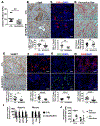Simultaneous inhibition of hedgehog signaling and tumor proliferation remodels stroma and enhances pancreatic cancer therapy
- PMID: 29331808
- PMCID: PMC6203960
- DOI: 10.1016/j.biomaterials.2018.01.014
Simultaneous inhibition of hedgehog signaling and tumor proliferation remodels stroma and enhances pancreatic cancer therapy
Abstract
Pancreatic ductal adenocarcinoma (PDAC) is one of the deadliest cancers. It has an excessive desmoplastic stroma that can limit the intratumoral delivery of chemotherapy drugs, and protect tumor cells against radiotherapy. Therefore, both stromal and tumor compartments need to be addressed in order to effectively treat PDAC. We hereby co-deliver a sonic hedgehog inhibitor, cyclopamine (CPA), and a cytotoxic chemotherapy drug paclitaxel (PTX) with a polymeric micelle formulation (M-CPA/PTX). CPA can deplete the stroma-producing cancer-associated fibroblasts (CAFs), while PTX can inhibit tumor proliferation. Here we show that in clinically relevant PDAC models, M-CPA effectively modulates stroma by increasing microvessel density, alleviating hypoxia, reducing matrix stiffness while maintaining the tumor-restraining function of extracellular matrix. M-CPA/PTX also significantly extends animal survival by suppressing tumor growth and lowering the percentages of poorly to moderately differentiated tumor phenotypes. Our study suggests that using multifunctional nanoparticles to simultaneously target stromal and tumor compartments is a promising strategy for PDAC therapy.
Keywords: Cancer-associated fibroblast; Pancreatic cancer; Polymeric micelles; Sonic hedgehog signaling; Stromal modulation.
Copyright © 2018. Published by Elsevier Ltd.
Figures







Similar articles
-
Stromal Modulation Reverses Primary Resistance to Immune Checkpoint Blockade in Pancreatic Cancer.ACS Nano. 2018 Oct 23;12(10):9881-9893. doi: 10.1021/acsnano.8b02481. Epub 2018 Sep 21. ACS Nano. 2018. PMID: 30231203 Free PMC article.
-
Cyclopamine-loaded core-cross-linked polymeric micelles enhance radiation response in pancreatic cancer and pancreatic stellate cells.Mol Pharm. 2015 Jun 1;12(6):2093-100. doi: 10.1021/mp500875f. Epub 2015 May 12. Mol Pharm. 2015. PMID: 25936695 Free PMC article.
-
Codelivery of small molecule hedgehog inhibitor and miRNA for treating pancreatic cancer.Mol Pharm. 2015 Apr 6;12(4):1289-98. doi: 10.1021/mp500847s. Epub 2015 Feb 25. Mol Pharm. 2015. PMID: 25679326 Free PMC article.
-
Pancreatic cancer stroma: understanding biology leads to new therapeutic strategies.World J Gastroenterol. 2014 Mar 7;20(9):2237-46. doi: 10.3748/wjg.v20.i9.2237. World J Gastroenterol. 2014. PMID: 24605023 Free PMC article. Review.
-
Stromal expression of SPARC in pancreatic adenocarcinoma.Cancer Metastasis Rev. 2013 Dec;32(3-4):585-602. doi: 10.1007/s10555-013-9439-3. Cancer Metastasis Rev. 2013. PMID: 23690170 Review.
Cited by
-
Multi-Modal Multi-Spectral Intravital Macroscopic Imaging of Signaling Dynamics in Real Time during Tumor-Immune Interactions.Cells. 2021 Feb 25;10(3):489. doi: 10.3390/cells10030489. Cells. 2021. PMID: 33668735 Free PMC article.
-
Hedgehog signaling in gastrointestinal carcinogenesis and the gastrointestinal tumor microenvironment.Acta Pharm Sin B. 2021 Mar;11(3):609-620. doi: 10.1016/j.apsb.2020.10.022. Epub 2020 Oct 29. Acta Pharm Sin B. 2021. PMID: 33777671 Free PMC article. Review.
-
Advanced iron oxide nanotheranostics for multimodal and precision treatment of pancreatic ductal adenocarcinoma.Wiley Interdiscip Rev Nanomed Nanobiotechnol. 2022 Jul;14(4):e1793. doi: 10.1002/wnan.1793. Epub 2022 Apr 9. Wiley Interdiscip Rev Nanomed Nanobiotechnol. 2022. PMID: 35396932 Free PMC article. Review.
-
Targeting Tumour-Associated Fibroblasts in Cancers.Front Oncol. 2022 Jun 22;12:908156. doi: 10.3389/fonc.2022.908156. eCollection 2022. Front Oncol. 2022. PMID: 35814453 Free PMC article. Review.
-
Recent advances in drug delivery and targeting for the treatment of pancreatic cancer.J Control Release. 2024 Feb;366:231-260. doi: 10.1016/j.jconrel.2023.12.053. Epub 2024 Jan 4. J Control Release. 2024. PMID: 38171473 Free PMC article. Review.
References
-
- Tempero MA, Berlin J, Ducreux M, Haller D, Harper P, Khayat D, Schmoll HJ, Sobrero A, Van Cutsem E, Pancreatic cancer treatment and research: an international expert panel discussion, Ann. Oncol. 22(7) (2011) 1500–6. - PubMed
-
- Kalluri R, The biology and function of fibroblasts in cancer, Nat. Rev. Cancer 16(9) (2016) 582–98. - PubMed
Publication types
MeSH terms
Substances
Grants and funding
LinkOut - more resources
Full Text Sources
Other Literature Sources
Medical

